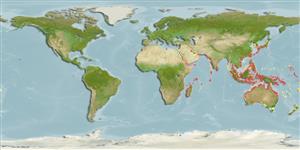>
Gobiiformes (Gobies) >
Gobiidae (Gobies) > Amblyopinae
Etymology: Paratrypauchen: The generic name is derived from the Greek Para, meaning beside or near, alluding to the similarity with Trypauchen. The gender is masculine..
More on author: Bleeker.
Environment: milieu / climate zone / depth range / distribution range
Ecología
marino; salobre demersal; rango de profundidad 0 - 10 m (Ref. 86942). Tropical
Indo-West Pacific: Natal to Kenya, through India, Indonesia to the Philippines. Also known from Wakayama, Niigata and Kumamoto Prefecture (Japan), the Korean Peninsula, China, and Malaysia (Ref. 559). Also from Singapore, Mozambique (Ref. 92840).
Tamaño / Peso / Age
Maturity: Lm ? range ? - ? cm
Max length : 18.0 cm TL macho / no sexado; (Ref. 4343)
Espinas dorsales (total): 6; Radios blandos dorsales (total): 48-51; Espinas anales 0; Radios blandos anales: 45 - 47
Inhabits soft mud bottoms, river mouths areas near mangrove forests; omnivore feeding on benthic invertebrates like crustaceans (Ref. 92840). Burrows in mud or shingle areas in inshore and estuarine waters (Ref. 4343, 11230).
Life cycle and mating behavior
Madurez | Reproducción | Puesta | Huevos | Fecundidad | Larva
Maugé, L.A., 1986. Gobiidae. p. 358-388. In J. Daget, J.-P. Gosse and D.F.E. Thys van den Audenaerde (eds.) Check-list of the freshwater fishes of Africa (CLOFFA). ISNB, Brussels; MRAC, Tervuren; and ORSTOM, Paris. Vol. 2. (Ref. 4343)
IUCN Red List Status (Ref. 130435)
Threat to humans
Harmless
Human uses
Pesquerías: escaso valor comercial; Acuario: Comercial
Más información
Nombres comunesSinónimosMetabolismoDespredadoresEcotoxicologíaReproducciónMadurezPuestaAgregación para la puestaFecundidadHuevosEgg development
ReferenciasAcuiculturaPerfil de acuiculturaRazasGenéticaElectrophoresesheritabilidadEnfermedadesProcesamientoNutrientsMass conversion
Herramientas
Special reports
Download XML
Fuentes de Internet
Estimates based on models
Preferred temperature (Ref.
123201): 23.6 - 29.2, mean 28.4 °C (based on 2768 cells).
Phylogenetic diversity index (Ref.
82804): PD
50 = 1.0000 [Uniqueness, from 0.5 = low to 2.0 = high].
Bayesian length-weight: a=0.00417 (0.00263 - 0.00661), b=2.90 (2.77 - 3.03), in cm total length, based on LWR estimates for this species & (Sub)family-body (Ref.
93245).
Nivel trófico (Ref.
69278): 3.7 ±0.4 se; based on size and trophs of closest relatives
Resiliencia (Ref.
120179): Medio, población duplicada en un tiempo mínimo de 1.4-4.4 años (Preliminary K or Fecundity.).
Fishing Vulnerability (Ref.
59153): Low vulnerability (10 of 100).
